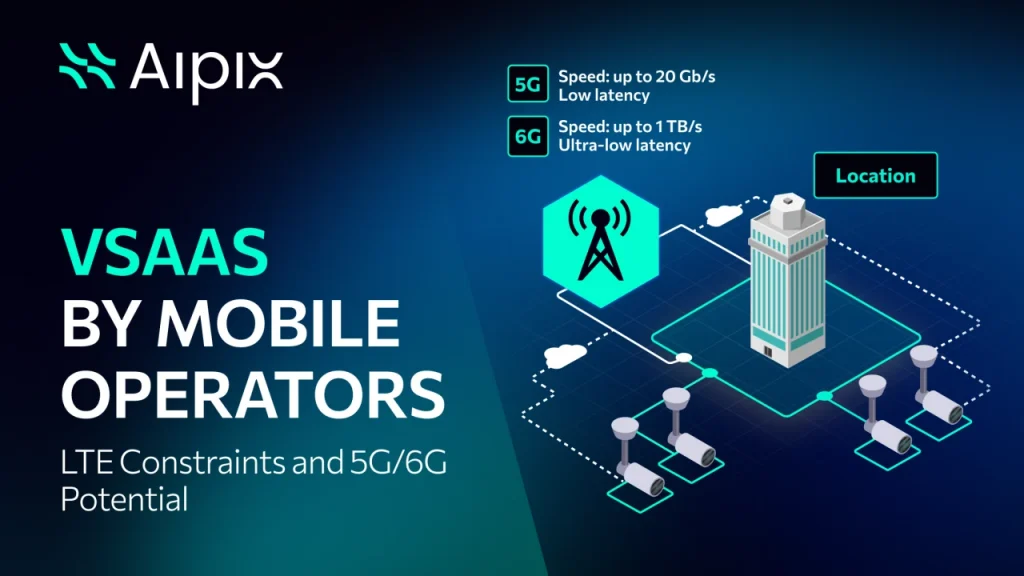VSaaS for Mobile Operators
LTE Constraints and 5G/6G Potential
Mobile operators are increasingly capable of providing video surveillance services over mobile networks, transforming traditional connectivity roles into platforms for advanced Value-Added Services (VAS). These services, which include real-time monitoring, cloud-based storage, and AI-driven analytics, are becoming integral to smart city infrastructure, industrial monitoring, and even remote healthcare applications. Video Surveillance as a service by mobile operators allows them to answer the growing demand in safety innovations. Despite negotiations, most powerful solutions, including Aipix, integrate seamlessly with 4G, 5G, and even private LTE networks, enabling features like instant object AI-recognition, behavioral pattern detection, and automated alerting.
Let’s explore each of the opportunities in video surveillance service provisioning across networks of different levels, from legacy 3G systems to advanced 5G and private LTE infrastructures. Each tier of connectivity brings its own unique set of capabilities and constraints that shape the way surveillance services can be deployed, scaled, and optimized. By examining them individually, we can better understand where real value lies and how operators can strategically position themselves in this evolving market.

Video Surveillance Over LTE: Possibilities and Pitfalls
While video surveillance over mobile networks is technically feasible and increasingly attractive. It’s important to understand that LTE networks weren’t originally built with this use case in mind. Cloud video surveillance as a concept predates the widespread rollout of LTE and fiber-optic broadband. Now, as mobile operators explore offering video surveillance as a service (VSaaS), especially to mass markets, they face both technical hurdles and regulatory challenges.
Technical Limitations of 3G/4G/LTE for Video Surveillance Service as a Service provided by Mobile Operators
A core issue lies in the fundamental design of LTE and earlier networks like 3G and 4G. These were engineered with a strong focus on downlink traffic, essentially delivering data to end users for streaming, browsing, and app usage. In contrast, video surveillance generates heavy uplink traffic, as cameras continuously send footage to cloud servers or control centers. This mismatch leads to several performance bottlenecks:
- Limited uplink bandwidth. Most video streams can quickly overwhelm this bandwidth, particularly in urban areas where camera density is high.
- Traffic imbalance and congestion. A sudden surge in uplink traffic, such as during an emergency when multiple cameras go live, can destabilize the network, degrade service for other users, and even disrupt base station operations.
- Reduced quality of service. The increased strain on uplink channels can result in jitter, packet loss, latency spikes, and in worst-case scenarios, dropped connections, making the surveillance unreliable when it’s needed most.
A real-world example is seen in early smart city deployments. It includes municipalities partnered with telecom providers to connect surveillance cameras via LTE. While initial performance was promising, large-scale rollouts exposed network weaknesses, especially during peak usage times or in dense environments. These experiences have pushed operators to explore hybrid solutions. They are involving edge processing, AI compression algorithms, and network slicing in 5G to mitigate these issues.
Ultimately, while LTE can support video surveillance on a limited scale, mass deployment demands smart planning, traffic prioritization, and evolving toward 5G or private mobile networks tailored to high uplink use cases.
Mechanisms to Compensate for Limitations in Video Surveillance Over 3G/4G/LTE
Although 3G/4G/LTE networks weren’t originally designed for high-bandwidth uplink use cases like video surveillance, mobile operators can still offer these services by applying a few strategic limitations. These compensatory mechanisms are essential to prevent network overload and ensure consistent service quality across all users.
Key approaches include:
- Restricting the number of connected cameras per subscriber, often to just 1–3 devices, to keep uplink traffic manageable.
- Using modems with capped uplink speeds, which helps prevent individual users from consuming excessive bandwidth and causing congestion.
- Limiting video stream quality, typically to standard definition (SD) or basic high definition (HD). While avoiding higher-bitrate formats like Full HD or 4K that could strain the network.
These constraints help maintain network stability and minimize performance degradation for other subscribers sharing the same cellular infrastructure. While they may reduce the overall quality of the surveillance experience, they strike a necessary balance between service viability and network health, especially in environments where LTE is the primary mode of connectivity.
The rise of 5G, and the anticipated arrival of 6G, is set to radically transform the way video is delivered. What was once a domain dominated by wired infrastructure and proprietary hardware is rapidly evolving into a dynamic, scalable, and service-driven ecosystem powered by mobile networks.
This transformation doesn’t just hinge on a faster internet. It’s about the reimagining of infrastructure to support real-time, data-heavy, mission-critical services like Video Surveillance as a Service (VSaaS). With 5G/6G, mobile operators are no longer just providing connectivity, they’re becoming platforms for intelligence, security, and automation.
From Connectivity to Capability: What Makes 5G/6G a Game-Changer for Surveillance
Unlike previous generations, the main 5G and 6G networks aim from the ground up to support next-gen applications. Those needs are as augmented reality, industrial automation, and of course, intelligent video surveillance. These networks allow optimizing not just for speed but for performance under pressure, where latency, reliability, and density are as critical as bandwidth.
Key Benefits of 5G/6G for Video Surveillance
- Symmetric Bandwidth.
Traditional mobile networks like 3G and 4G prioritized downlink traffic to support content consumption. In surveillance, however, it’s the uplink, the path from the camera to the server, that matters most. 5G/6G deliver balanced and scalable throughput in both directions. This enables real-time video streams even from high-resolution cameras to be uploaded to the cloud without compromising quality or stability. - Ultra-Low Latency.
Latency under 5ms in 5G (and even sub-millisecond in 6G) makes it possible to support situational awareness, real-time alerts, and on-the-fly analytics.
What is the result? In critical scenarios like perimeter security or live traffic monitoring, this speed can be the difference between prevention and reaction. - Massive Device Density.
5G supports over 1 million devices per square kilometer, allowing thousands of cameras, sensors, and smart devices to operate simultaneously in dense environments. This scalability is crucial for Smart Cities and large-scale facilities where traditional networks would be quickly overwhelmed.
Together, these capabilities don’t just improve video surveillance. They enable entirely new models of deployment, particularly in complex urban and industrial settings. But the technical improvements are only part of the story. The true value lies in how operators package these capabilities and deliver through innovations like network slicing.
Network Slicing: Building Dedicated Surveillance Highways in Shared Networks
One of the most profound architectural innovations introduced with 5G is network slicing. Think of it as carving out private, tailor-made “lanes” within a shared superhighway. Each lane (or slice) can be optimized for a specific use case. And video surveillance is one of the most compelling.
How Network Slicing Elevates Video Surveillance
- Dedicated Slices for Video Surveillance.
Operators can allocate specific slices with guaranteed service levels bandwidth, latency, jitter, and security just for video streaming. This ensures uninterrupted service, even when other parts of the network are under heavy load from consumer traffic or entertainment streaming. - Fault Isolation and Resilience.
Slices operate independently, so issues in the broader network don’t cascade into surveillance services. This is mission-critical for public safety, industrial sites, and transport hubs where continuous monitoring is essential. - QoS Fine-Tuning.
Operators can customize traffic priorities by device, data type (video vs metadata), or location. Surveillance for high-risk zones can receive higher priority than general-purpose camera feeds, maximizing effectiveness. - Multi-Service Integration within a Slice.
Within a surveillance slice, operators can combine live cameras, cloud analytics, storage, AI-powered alerting systems, and more, effectively offering Video as a Service (VSaaS) as a unified, turnkey package. This reduces complexity for clients and opens the door to managed service offerings from telecom operators.
By leveraging slicing, surveillance becomes more than just a network workload, it becomes a premium service tier, with high reliability and monetizable value.
Commercial and Technological Potential: A New Role for Telecoms
With 5G/6G, telecom operators are stepping into a much broader role. No longer are they just bandwidth providers — they’re becoming end-to-end service enablers, helping cities, enterprises, and even homeowners secure their environments with intelligent, scalable surveillance solutions.
Opportunities for Operators
- VSaaS Monetization.
Operators can offer surveillance as a subscription service to B2C and B2B markets — covering installation, network connectivity, analytics, and storage. This creates recurring revenue streams and shifts the business model from CAPEX-heavy hardware sales to OPEX-friendly services. - Expansion of IoT Ecosystems.
Surveillance is a natural extension of smart home, smart factory, and smart city initiatives, where video integrates with motion sensors, access control, and AI. This deepens customer engagement and increases device stickiness. - Public Sector and Smart City Engagement.
5G/6G-enabled surveillance can power city-wide security systems, traffic control, environmental monitoring, and public event oversight. Operators can position themselves as strategic partners in digital urban transformation initiatives.
These opportunities represent a significant leap forward, but they are not without challenges. The transition to 5G/6G-powered surveillance demands a solid foundation.
Key Challenges on the Path to Next-Gen Surveillance
Infrastructure Demands
- Full Network Modernization.
End-to-end 5G/6G deployment, radio access, transport, and core is essential to support low-latency, high-throughput video workloads. Operators must invest heavily and strategically to ensure scalability and geographical coverage. - Hardware Compatibility.
Surveillance equipment (cameras, encoders, modems) must support next-gen communication standards and edge intelligence. Backwards compatibility and fleet upgrades will be a key consideration, especially for large enterprises or municipalities. - Network Engineering and Resilience.
With more services relying on real-time video, networks must be designed for graceful degradation, redundancy, and dynamic resource allocation. Advanced orchestration and AI-driven management tools will become essential for operators to maintain service levels.
Final Thoughts: From Connectivity to Intelligence
In the emerging era of 5G and 6G, video surveillance is no longer just a feature, it’s a strategic pillar of smart infrastructure. With capabilities like symmetric bandwidth, ultra-low latency, massive connectivity, and network slicing, telecom networks are becoming intelligent platforms capable of hosting critical security services.
For operators, this presents a rare opportunity: to transform from network providers into ecosystem leaders, delivering high-value, secure, and scalable surveillance services to businesses, governments, and homes alike.
As cities become smarter and security becomes more data-driven, the role of telecoms in surveillance will only grow more central. And those who invest in the right infrastructure, partnerships, and service models today will define the surveillance landscape of tomorrow.
Aipix is perfectly designed for Video Surveillance as a Service by Mobile Operators. Our solution is addressed to every major requirement for modern video surveillance in the 5G and 6G era. Its smart edge devices, flexible cloud integration, and AI-driven analytics create a complete, real-time surveillance solution. Aipix supports ultra-low latency streaming, dynamic bandwidth use, and quick deployment across urban, industrial, and enterprise settings. With full compatibility for network slicing and end-to-end service management, it helps telecom operators deliver high-value VSaaS with guaranteed reliability and performance.
If you’re ready to future-proof your video surveillance offering, fill out our contact form today — let’s build the next generation of smart security together!
Get your "VAS & VSaaS Report 2025"
Leave your e-mail and we’ll send you the file





